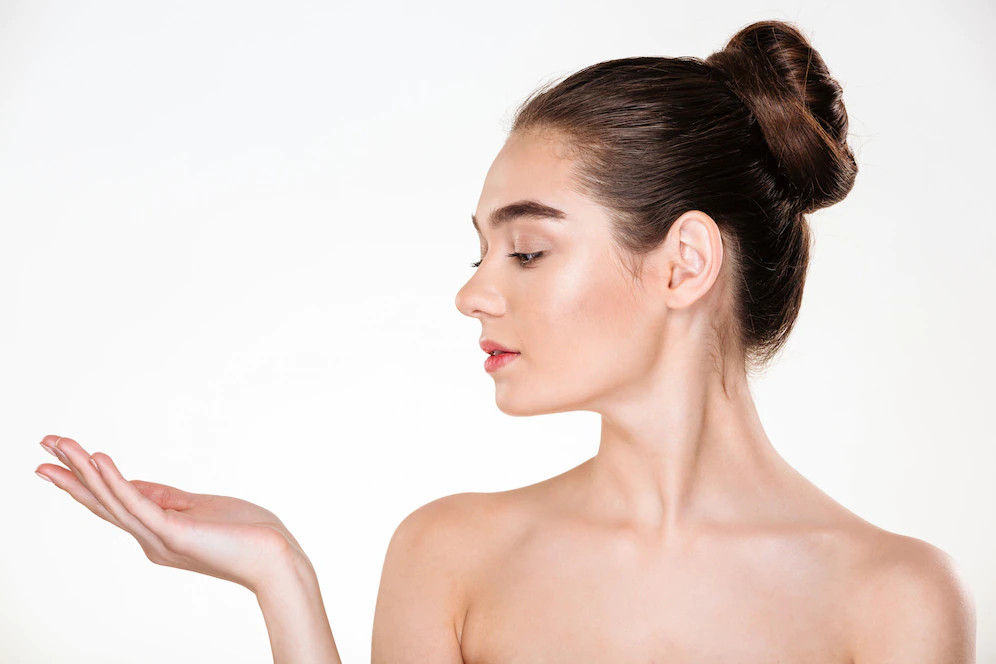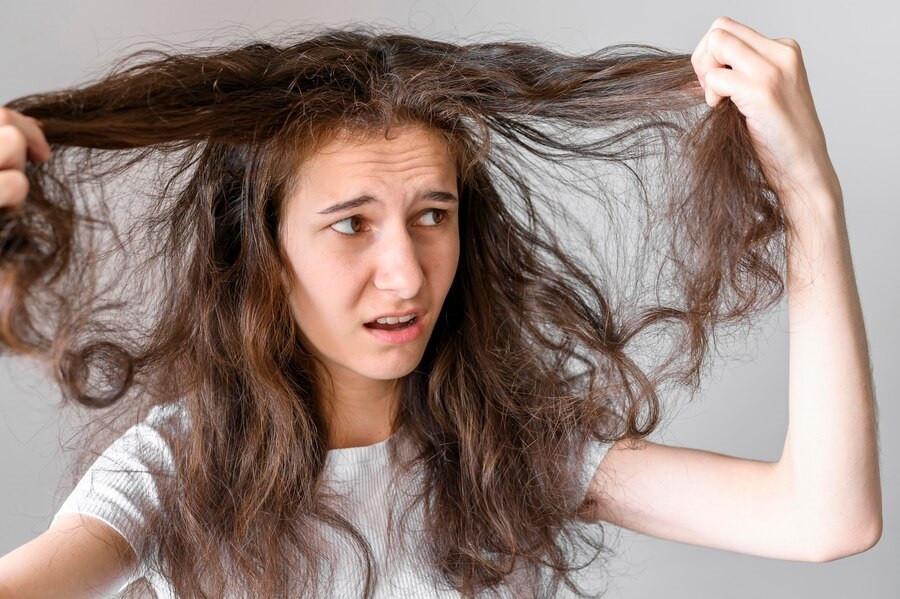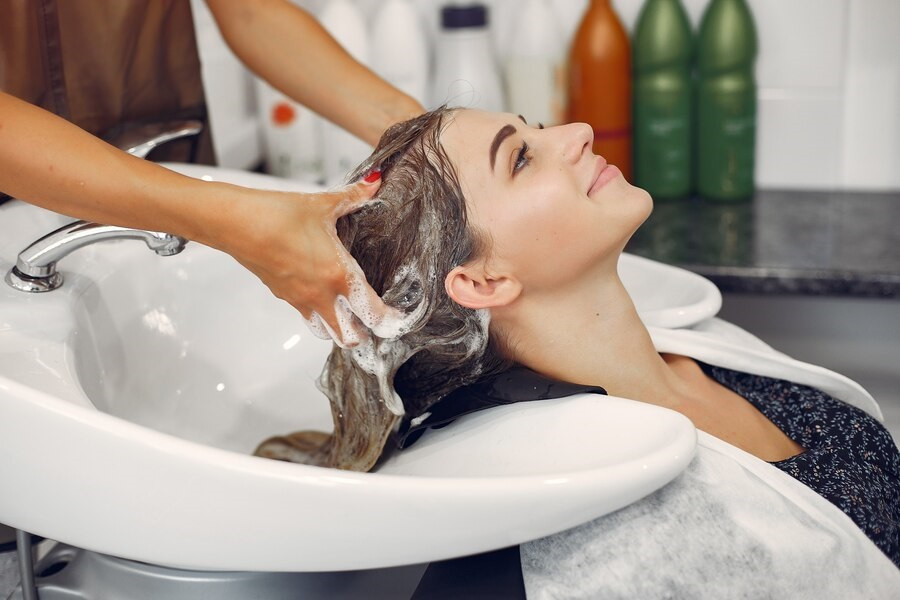Bleaching rambut merupakan proses kimia di mana pigmen alami dalam rambut dihilangkan sehingga rambut menjadi lebih terang atau berwarna putih. Proses ini dilakukan menggunakan bahan kimia seperti hidrogen peroksida atau amonia, untuk membuka lapisan kutikula rambut dan menghilangkan pigmen alaminya.
Biasanya setelah proses bleaching selesai, rambut akan diwarnai kembali dengan cat rambut sehingga warna yang dipilih atau diinginkan lebih mudah diaplikasikan. Dengan melewati proses bleaching, cat warna pada rambut menjadi lebih terlihat.
Risiko Bleaching Rambut
Hidrogen peroksida adalah bahan kimia yang umum digunakan dalam proses bleaching rambut dan juga pewarnaan rambut. Walaupun dikatakan cukup aman, namun penggunaan berlebihan dapat berdampak negatif pada rambut, di antaranya:
- Dapat menyebabkan iritasi di kulit kepala dan sekitar garis rambut
- Menyebabkan kerusakan kutikula (lapisan terluar rambut) sehingga ujung rambut mudah bercabang dan kusut
- Reaksi kimia hidrogen peroksida menyebabkan stres oksidatif pada rambut sehingga memicu kerusakan pada folikel rambut dan meningkatkan risiko kerontokan rambut
Baca Juga: Memilih Sampo Sesuai Jenis Rambut
Cara Merawat Rambut yang Rusak Akibat Bleaching
Merawat rambut yang rusak akibat bleaching membutuhkan perawatan yang intensif dan hati-hati untuk mengembalikan kelembapan, kekuatan dan kesehatan rambut. Berikut adalah beberapa cara yang bisa dilakukan untuk merawat rambut rusak setelah proses bleaching:
Menggunakan sampo dan kondisioner yang tepat
Untuk merawat rambut yang kering, Anda perlu memilih produk perawatan rambut termasuk sampo dan kondisioner yang dirancang khusus untuk rambut yang rusak dan kering. Sampo yang lembut dan bebas dari sulfat membantu menjaga kelembapan alami rambut.
Anda juga perlu menggunakan kondisioner yang kaya akan bahan-bahan pelembap alami seperti minyak argan, minyak kelapa, minyak zaitun, minyak almond atau air cucian beras. Leave in conditioner juga merupakan produk kondisioner yang cocok untuk jenis rambut kering karena dapat menjaga kelembapan lebih lama.
Menggunakan masker rambut secara teratur
Masker rambut adalah perawatan rambut tambahan yang juga penting untuk merawat rambut yang rusak akibat bleaching. Untuk mengembalikan kesehatan rambut, Anda perlu memilih jenis masker rambut yang mengandung bahan-bahan seperti protein, keratin, atau minyak alami. Bahan-bahan ini dapat membantu memperbaiki kerusakan dan mengembalikan kelembapan rambut. Gunakan masker rambut setidaknya seminggu sekali atau sesuai dengan kebutuhan rambut Anda.
Menghindari penggunaan alat pemanas
Rambut yang telah melalui proses bleaching cenderung lebih rentan terhadap kerusakan akibat panas dari alat-alat styling seperti hair dryer, catok, atau alat pengeriting rambut. Sebaiknya hindari penggunaan alat pemanas sebisa mungkin, atau atur alat pada suhu rendah untuk mengurangi risiko kerusakan rambut.
Baca Juga: 5 Kesalahan Umum Keramas yang Memengaruhi Kesehatan Rambut
Melakukan trimming rambut secara teratur
Memotong ujung rambut (trimming) secara teratur dapat menghilangkan ujung rambut yang rusak dan bercabang. Cara ini efektif untuk mencegah kerusakan rambut lebih lanjut dan membuat tampilan rambut lebih sehat.
Meminimalkan pemrosesan kimia tambahan
Setelah proses bleaching, hindari pemrosesan kimia tambahan seperti pewarnaan ulang atau proses pengeriting rambut yang menggunakan bahan kimia. Lebih baik berikan waktu istirahat bagi rambut untuk pulih secara alami sehingga dapat membantu meminimalkan kerusakan lebih lanjut.
Tidak menyisir rambut yang basah
Rambut yang disisir dalam kondisi basah lebih rentan terhadap kerusakan. Hindari menyisir rambut dalam kondisi basah agar rambut tidak mudah patah. Apabila Anda ingin merapikannya, lebih baik gunakan sisir bergigi jarang atau gunakan jari-jari Anda saja.
Dengan perawatan yang tepat dan konsisten, rambut yang rusak akibat bleaching bisa pulih dan kembali sehat. Namun, apabila Anda mengalami kerontokan parah, iritasi yang tidak membaik, atau kerusakan rambut yang berlanjut, sebaiknya konsultasikan dengan ahli dermatologi atau penata rambut profesional untuk mendapatkan saran lebih lanjut.
Memiliki keluhan atau pertanyaan lain terkait kesehatan rambut? Anda bisa memanfaatkan layanan konsultasi kesehatan dengan mengunduh aplikasi Ai Care melalui App Store atau Play Store.
Mau tahu tips dan trik kesehatan, pertolongan pertama, dan home remedies lainnya? Cek di sini, ya!
- dr. Monica Salim
Mallika Bhattacharya (2022). What to Know About Hair Bleach. Available from: https://www.webmd.com/beauty/what-to-know-about-hair-bleach
Kathryn Watson (2020). 22 Tips to Hydrate and Repair Hair After Bleaching. Available from: https://www.healthline.com/health/beauty-skin-care/how-to-hydrate-hair-after-bleaching
Erin Jahns (2023). 11 Expert-Approved Tips to Fix Bleached, Damaged, and Over-Processed Hair. Available from: https://www.byrdie.com/how-to-fix-bleached-hair
Valencia Higuera (2023). Why Do I Have Dry Hair?. Available from: https://www.healthline.com/health/dry-hair
Erica Hersh (2019). Is Lightening Your Hair with Hydrogen Peroxide Damaging?. Available from: https://www.healthline.com/health/hydrogen-peroxide-hair
Rachel Ann Tee-Melegrito (2023). How to use hair serum: Dos and Don’ts. Available from: https://www.medicalnewstoday.com/articles/how-to-use-hair-serum
WebMD (2022). Dry Hair: Symptoms, Causes, and Treatments. Available from: https://www.webmd.com/beauty/dry-hair-causes
Grace Gallagher (2019). Everything You Need to Know About Using a Hair Mask. Available from: https://www.healthline.com/health/how-to-use-hair-mask
Annette McDermott (2024). How to Conceal or Get Rid of Split Ends. Available from: https://www.healthline.com/health/how-to-get-rid-of-split-ends
Del Sandeen (2023). 4 Signs You Need a Hair Trim. Available from: https://www.byrdie.com/signs-you-need-a-hair-trim-400151











